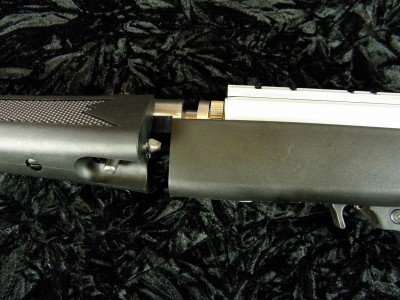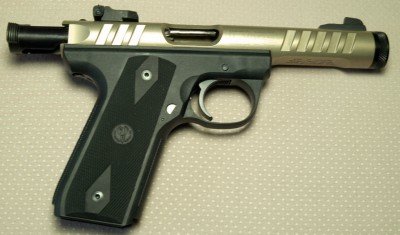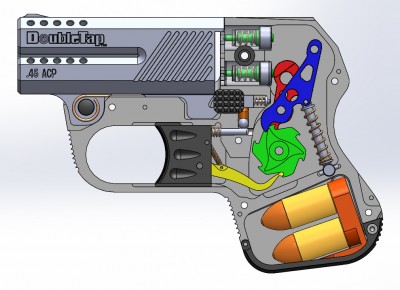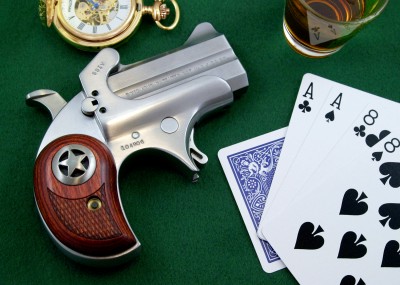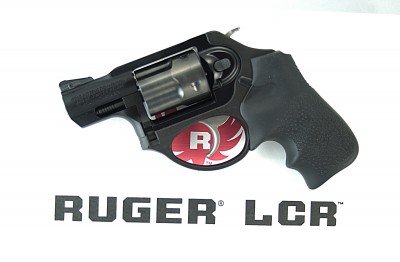Pellet guns let you to bring your shooting home and AirForce, a small manufacturing company in Fort Worth, Texas, makes some great guns to do it with. We tested their two most popular models, the Talon SS and the Condor, out at the ranch on a typical north Texas summer day.
There are basically three types of air guns: spring guns which must be cocked prior to each shot, CO2 guns which use small canisters of carbon dioxide as propellant, and pre-charged pneumatic (PCP) guns which use compressed air. The advantages of a PCP gun over the other two types are that they can be more powerful, they shoot more consistently, there is virtually no recoil, and follow-up shots are faster and easier since the gun doesn’t have to be cocked between shots. Read More…
Wayne Lincourt – Managing Editor
Show First
AirForce Airguns – Talon SS and Condor – For Fun Shooting
Updated: June 26, 2011Vanguard Endeavor ED 1045 Binoculars
Updated: September 11, 2011
Value means getting more than you paid for, and that’s exactly what you get with Vanguard’s Endeavor ED binoculars. For binoculars with the performance and features they offer, you would typically pay 50% to 500% more.
The MRSP on the Vanguard Endeavor ED 1045 is $499, but I found them on Optics Planet for $399 and on Amazon for $379. Until November 30th there is also a special running from Vanguard that you can get a shooting stick or other accessories free when you buy a pair of these great binocs. The direct link to the promotion is: https://www.vanguardworld.com/index.php/en/os/component/content/article/6-other/137-free-shooting-stick-with-binoculars-purchase.html
The Endeavor provides 10.5 x magnification with 45 mm objective lenses. Typical sport binoculars in this power range have 42 mm lenses. The larger 45 mm objective lenses gather more light with an inconsequential trade-off in weight and size. Compared to the Vanguard ED 10 x 42 binoculars, the 10.5 x 45 add a little more than an ounce in weight and 2 mm (less than eight hundredths of an inch) in width. The added brightness is well worth the minimal weight penalty.
To get the best image quality, binoculars have to basically do two things well: transmit as much light as possible, and focus the image clearly. Glass lenses reflect some of the light from their front surfaces and the inside of their back surfaces, anyplace that glass and air touch. That’s the flash you see if you happen to be in front of someone using binoculars or a telescope. Anti-reflection (AR) lens coatings assist in light transmission and also reduce ghosting and flare. Binoculars designated as AR “Coated” have a single layer of coating on at least some of the lens surfaces. This helps but multiple layers are much more effective. You’ll know if they have multiple layers if they say “Multi Coated.” “Fully Coated” means that all glass to air surfaces are coated, and the very best binoculars have “Fully Multi Coated” lenses, like the Vanguard Endeavor.
The second problem area for light transmission is the prisms. Quality binoculars generally use one of two types of prisms: poro prisms or roof prisms. You can tell if a pair of binoculars uses poro prisms because the objective lenses are wider than the eyepieces; the prisms are mounted side-by-side inside the binoculars.
Roof prisms are mounted in-line, making the binoculars sleeker and more compact, however roof prisms require better coatings and more precise manufacturing than poro prisms, which is why roof prism binoculars typically cost more. The Vanguard Endeavor uses a combination of roof prisms, BaK4 prism glass (which is superior to BaK7 glass used in cheaper binoculars), and special phase coatings, for optimum performance.
Of course, the quality of the lenses is responsible for the quality of the image, and the Endeavor uses ED or extra low dispersion glass which makes the very best lenses. Binoculars with ED lenses actually use a pair of objective lenses, or a lens couplet, in each tube to reduce chromatic dispersion. Chromatic dispersion stems from the fact that the different colors or wavelengths of light which make up white light (think rainbow), focus at slightly different points, creating a slightly fuzzy image. The second lens in the ED couplet corrects the dispersion created by the first lens, resulting in a sharp, clear image with fine detail resolution. That’s important if you’re trying to count the points on a deer at 300 yards or to see anything in low light conditions.
The Endeavor utilizes a magnesium alloy body for lightness and strength, rubber cladding to ensure a secure grip, and is nitrogen purged to eliminate fogging and protect the internals from oxidation. They also incorporate O ring seals to make them waterproof. That doesn’t mean you can take them to 90 feet on your next diving trip. They are guaranteed waterproof to 3.3 feet, which is more than enough to keep the rain out and provide a little insurance in case you drop them in the water at your duck blind.
Ultimate Plinker – New Ruger SR22 Pistol
Updated: January 2, 2012Every gun nut looks for that perfect .22 pistol that will always be a staple of their gun collection. Even if you have more than one, and most of us do have several, a .22 pistol is lifetime purchase, so even though they are less expensive than most centerfire pistols, you have to choose carefully.
The “old” Ruger .22LR pistol, currently called the Mark III, is one of those guns you can always advise someone to choose and they will never regret it. The classic Luger lines of the gun and the hefty weight of 30oz. and up make it easy to shoot for novice shooters, and steady and accurate for a lifetime of punching paper and eliminating the dreaded grey squirrel. The Ruger Mark III will never let you down. But the world has moved on from steel guns, and most people want a .22LR pistol that looks and feels like the centerfire pistol they use for home defense, concealed carry, or competition.
Ruger LCR-22 New Gun Review
Updated: January 15, 2012
Break out the party hats, Ruger’s LCR just got a little brother! The newest member of the LCR family shares all the great features of its brethren and is now available in .22 caliber. The LCR-22 is light, fast handling, and accurate for a 1.875” barrel, and it’s a ball to shoot.
If you’re not familiar with Ruger’s LCR (Lightweight Compact Revolver) which debuted in January of 2009, it is best known as the first production polymer framed revolver. Several others have come out since but Ruger was ahead of the pack with the LCR.
The polymer lower part of the frame houses all components of the fire control mechanism and is mated to an aluminum alloy upper which houses the stainless steel cylinder and barrel liner. Polymer is a rugged material, rust and corrosion proof, and light weight. The aluminum upper and heavy fluting on the cylinder contribute additional weight savings. My review gun came in at 14.8 ounces empty on my stamps.com electronic scale, but the reported weight is 14.9 ounces. The balance point is at the back of the cylinder which I consider ideal for a snub nose revolver. It comes on target out of the holster quickly, thanks in part to the great balance as well as the natural grip angle and excellent rubber grip from Hogue.
The hammer is completely enclosed making, this a double-action-only (DAO) revolver and eliminating a potential snag for anyone interested in concealed carry. The DAO trigger, like its bigger brothers, is very smooth with no stacking and little overtravel. It measured right around 12 pounds but didn’t seem that much thanks to the way they cam the trigger.
The LCR-22 is compact, little more than 6.25” long and 1.25” wide. It sits so lightly in a holster or in your pocket that you’ll forget it’s there
The big news, of course is that you can now get it in .22 caliber which opens the opportunity to do a lot more shooting since .22 ammo is inexpensive and widely available. The LCR-22 will handle .22 short, .22 long, and .22 long rifle ammo, including shot shells, which means that you can personalize it for your needs.
I see this fun little revolver filling a number of roles. The most important component to shooting any gun accurately, aside from the gun itself, is practice. No matter how good (or bad) you are, more practice will make you better. Unfortunately, center fire ammo can get expensive, especially if you want to shoot hundreds of rounds a month. With a .22, you can shoot for pocket change.
Ruger 10/22-TD Takedown Model – New Gun Review
Updated: March 28, 2012The Ruger 10/22 generally needs no introduction. There is no more recognizable and ubiquitous .22 rifle on the planet. Today Ruger released a new 10/22-TD, MSRP $389, which stands for “Takedown,” and it is a completely new design for the gun. It even comes with its own backpack. You probably already have questions formulating. Takedown designs can sometimes have issues with accuracy, returning to zero and long term reliability, but Ruger seems to have addressed all of these going into the design of this new gun. From what I can see so far, the 10/22-TD should be a great long term success and a reliable gun for those fortunate enough to get one. You may have heard already that Ruger has stopped taking new orders temporarily from distributors because of record sales, but there should be plenty of them available at least for a couple weeks.
Ruger 22/45 Lite Mark III – New Gun Review
Updated: April 12, 2012If any gun is quintessentially Ruger, it’s their .22 caliber pistol. Originally designed by Bill Ruger in his garage, it was the very first gun Sturm, Ruger and Company sold, and has been in production continuously for nearly 63 years. It was a huge success from the get go and has continued to get better as new materials, new manufacturing methods, and other refinements have been made in response to consumer demand.
The 22/45 Model variation was introduced in 1992 to provide a training gun for the venerable 1911 Government Model .45. It has the same grip angle and control locations giving 1911 owners a less expensive alternative for perfecting their pistolcraft. In fact, it’s so faithful to the 1911 that you can use 1911 grips on it. All you have to do to make them work is to relieve the upper front corner of the left grip panel to accommodate the slide stop button. So if you have a set of the new Crimson Trace laser grips on your 1911, you can put them on your Ruger for training.
DoubleTap Defense .45ACP Pocket Derringer – New Gun Review
Updated: October 6, 2013The DoubleTap Tactical Pocket Pistol is an over/under break action derringer capable of delivering two rounds of 9 mm or .45ACP as fast as you can pull the trigger. It is sold as a simple and rugged option for deep concealment or backup. Make no mistake, this is not a range gun or plinker. It’s designed for one purpose and one purpose only – saving your life. We first saw the DoubleTap almost two years at SHOT Show 2012, but after some hiccups with manufacturing contracts and parts suppliers, the DoubleTap pistol is just now finding its way into the market. Our big question, and yours most likely, is the street practicality of the DoubleTap. The .45ACP is no kitten when it comes to recoil, and even though your followup shots are limited to one in the two shot pistol, an “ouch that hurts” after the first shot wouldn’t be the ideal in a concealed carry pistol. There are a lot of perfectly good pocket pistols on the market, and this gun has several red flags, as well as some outright user discomfort. At an MSRP starting at $499 for a two shot derringer, do we really need the DoubleTap?
Bond Arms Derringer – Range Report & Factory Tour
Updated: November 22, 2013If you like small guns, you’ll find the Bond Arms derringer both capable and versatile. Its capabilities stem from the fact that it’s not as punishing to shoot as you might expect. In fact, controllability and shootability are very good with every caliber shot for this review. Its versatility stems from the wide selection of barrels, calibers and grips available. Whichever of the eight models you select initially (nine including their new Backup model), you can add barrels and grips to turn it into any of the other models. Mix and match grips and barrels to customize it to your needs. Bond Arms’ price list shows a total of 21 barrels capable of firing 17 different calibers. Their 3” barrel, their most versatile, is available in .22LR, .22Mag, .327 fed mag, 9mm, .357/.38spl., .40 S&W, 10mm, .44spl., .44/40, .45GAP, .45ACP, .45Colt, and .45/.410 (2 ½” chamber). However, as in most guns that serve multiple needs, it does some things better than others. I toured the factory in Granbury, Texas, USA, with owner and president Gordon Bond to see just how these guns are made. With the exception of the 400 series stainless steel forgings from which the guns are machined, all the work is done in-house. It may be a small company, but that doesn’t mean they don’t use state-of-the-art equipment to ensure their high quality standards. From numerically controlled milling machines operating down to less than ten thousandths of an inch accuracy, to robotic arms which provide precision and repeatability in surface preparation, to the artistry of individual experts who assemble, polish, and time the function of the finished product — quality is their principal driver.
Ruger’s External Hammer LCR, the LCRx – New Gun Review – SHOT Show 2014 Preview
Updated: January 7, 2014The widely acclaimed Ruger LCR (Lightweight Compact Revolver) just got even better. As you know, the LCR is one of Ruger’s best-selling guns. They hit a home run when they introduced the first polymer revolver in January of 2009, and since then they’ve added several new versions to broaden the market for this revolutionary snub nose. The latest is the .38 spcl./.38spcl+P version with an external hammer—the LCRx. Don’t worry, the addition of the hammer hasn’t changed any of the great handling and shooting qualities of the double-action-only (DAO) LCR. It still has the same polymer lower housing that holds the fire control components, the same aluminum alloy upper and the same stainless steel barrel liner and cylinder. However, with this model you have the option of pulling the hammer back and firing in single-action (SA) mode.
Para 1911 Elite Commander—Gun Review
Updated: March 9, 2014The model 1911 pistol has been in demand for more than 100 years. That should tell you something about its design and capabilities. It was the official sidearm of the US Army from 1911 until 1985, when the Beretta 92F was adopted. The 1911 is still in use by elite units, however, like the Army Delta Force, Marine Special Operations Command and the 1st Special Forces Operational Detachment. These are the best of the best, who use their firearms in the most demanding situations. Buying a 1911 puts you in some very good company. If you happen to be interested in acquiring a quality 1911 at a value price, the Para Elite Commander deserves a look. When I say “value” price, I don’t mean the cheapest 1911 available. There are plenty around for less money. In fact, Para even has a line with a lower price-point. What I mean by “value” is a 1911 with all the enhancements you’d want for top accuracy and consistently dependable operation, at a reasonable price. The Para fits that bill. There’s even a way for you to save an extra hundred bucks off of the best price you can negotiate with your dealer. Read on to learn how.

